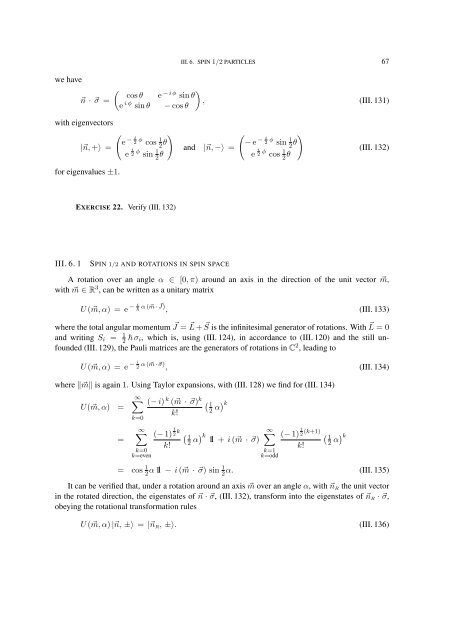FOUNDATIONS OF QUANTUM MECHANICS
FOUNDATIONS OF QUANTUM MECHANICS
FOUNDATIONS OF QUANTUM MECHANICS
You also want an ePaper? Increase the reach of your titles
YUMPU automatically turns print PDFs into web optimized ePapers that Google loves.
III. 6. SPIN 1/2 PARTICLES 67<br />
we have<br />
⃗n · ⃗σ =<br />
( cos θ e<br />
− i ϕ )<br />
sin θ<br />
e i ϕ , (III. 131)<br />
sin θ − cos θ<br />
with eigenvectors<br />
|⃗n, +⟩ =<br />
(<br />
)<br />
e − i 2 ϕ cos 1 2 θ<br />
e i 2 ϕ sin 1 2 θ<br />
and |⃗n, −⟩ =<br />
(<br />
)<br />
− e − i 2 ϕ sin 1 2 θ<br />
e i 2 ϕ cos 1 2 θ<br />
(III. 132)<br />
for eigenvalues ±1.<br />
EXERCISE 22. Verify (III. 132)<br />
III. 6. 1<br />
SPIN 1/2 AND ROTATIONS IN SPIN SPACE<br />
A rotation over an angle α ∈ [0, π) around an axis in the direction of the unit vector ⃗m,<br />
with ⃗m ∈ R 3 , can be written as a unitary matrix<br />
U (⃗m, α) = e − i α ( ⃗m · ⃗J) , (III. 133)<br />
where the total angular momentum J ⃗ = L ⃗ + S ⃗ is the infinitesimal generator of rotations. With L ⃗ = 0<br />
and writing S i = 1 2 σ i, which is, using (III. 124), in accordance to (III. 120) and the still unfounded<br />
(III. 129), the Pauli matrices are the generators of rotations in C 2 , leading to<br />
U (⃗m, α) = e − i 2 α ( ⃗m · ⃗σ) , (III. 134)<br />
where ∥⃗m∥ is again 1. Using Taylor expansions, with (III. 128) we find for (III. 134)<br />
∞∑ (− i) k (⃗m · ⃗σ) k (<br />
U(⃗m, α) =<br />
1<br />
k!<br />
2 α) k<br />
=<br />
k=0<br />
∞∑<br />
k=0<br />
k=even<br />
(− 1) 1 2 k ( 1<br />
k!<br />
2 α) ∑<br />
k ∞ 11 + i (⃗m · ⃗σ)<br />
k=1<br />
k=odd<br />
(− 1) 1 2 (k+1) ( 1<br />
k!<br />
2 α) k<br />
= cos 1 2 α 11 − i (⃗m · ⃗σ) sin 1 2α. (III. 135)<br />
It can be verified that, under a rotation around an axis ⃗m over an angle α, with ⃗n R the unit vector<br />
in the rotated direction, the eigenstates of ⃗n · ⃗σ, (III. 132), transform into the eigenstates of ⃗n R · ⃗σ,<br />
obeying the rotational transformation rules<br />
U (⃗m, α) |⃗n, ±⟩ = |⃗n R , ±⟩. (III. 136)
















